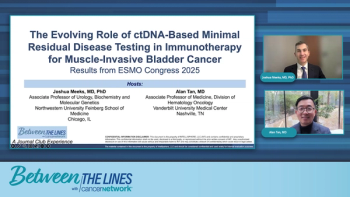
Managing Taste Changes and Weight Loss During Talquetamab Treatment
Panelists discuss how patients can maintain their nutrition during talquetamab treatment by focusing on texture and food presentation when taste is impaired, using high-calorie options, and remembering that taste changes and dry mouth are temporary adverse effects that improve over time.
Episodes in this series

Alan Plisskin’s experience with talquetamab included multiple GPRC5D-related toxicities including hand and foot peeling, complete fingernail loss, and some toenail loss, notably without associated pain. Taste changes lasted approximately 2 months, while dry mouth persisted for 6 months, and he experienced rare postinjection fevers. His positive outcome included 15 pounds of weight gain rather than the weight loss commonly associated with taste and appetite changes.
Nutritional management strategies focus on maximizing caloric density when the appetite is compromised, including high-calorie shakes such as Ensure, and adding healthy fats such as avocado to meals. Texture considerations become paramount when taste is altered, with patients often finding satisfaction in crunchy foods such as nuts or creamy textures when traditional flavors are diminished. Food presentation and making meals into "events" can help maintain interest in eating despite taste alterations.
The temporary nature of taste and appetite changes provides hope for patients struggling with these adverse effects during early treatment phases. Plisskin’s transition from every 2 weeks to monthly dosing as his disease responded illustrates how treatment intervals can be extended while maintaining efficacy, potentially reducing the frequency and severity of adverse effects. His testimony that "quality of life after the [adverse] effects is excellent" emphasizes that patients can return to feeling "normal" once the initial wave of toxicities resolves.
Newsletter
Stay up to date on recent advances in the multidisciplinary approach to cancer.




















































































